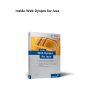Immunology Lecture Notes 7th Edition by Ian Todd, Gavin Spickett, Lucy Fairclough ISBN 9781118451632 1118451635
$70.00 Original price was: $70.00.$35.00Current price is: $35.00.
Instant download Lecture Notes Immunology 7th Edition after payment
Immunology Lecture Notes 7th Edition by Ian Todd, Gavin Spickett, Lucy Fairclough – Ebook PDF Instant Download/Delivery: 9781118451632, 1118451635
Full dowload Immunology Lecture Notes 7th Edition after payment

Product details:
ISBN 10: 1118451635
ISBN 13: 9781118451632
Author: Ian Todd, Gavin Spickett, Lucy Fairclough
Lecture Notes: Immunology
Immunology Lecture Notes 7th Table of contents:
Part 1: Immunity and the Immune System
1 The nature of immunity
Recognition and defence components
Innate and adaptive immunity
Stages of an immune response
Immunological defence strategies
An overview
Immunopathology
Self-Assessment Questions
2 Immune recognition
Recognition of PAMPs
Recognition of antigens
The HLA system and its proteins
Self-Assessment Questions
3 Lymphocyte development and activation
B-cell development
B-cell activation and maturation
T-cell development and education
T-cell subpopulations
Self-Assessment Questions
4 Lymphocyte interactions, cytokines and the lymphoid system
Cytokines and T-cell subpopulations
The lymphoid system
Lymphocyte recirculation and homing
Lymphocyte selection and maturation
Laboratory methods
Self-Assessment Questions
5 Immunoglobulins
Structure
Classes and subclasses
Triggering of effector systems
Immunoglobulin genes
Exploiting the properties of immunoglobulins: Laboratory methods
Self-Assessment Questions
6 Complement
The classical pathway (Fig. 6.3) and the lectin pathway
The alternative pathway (Fig 6.5)
The membrane attack pathway (Fig. 6.2)
Inadequate regulation of complement activation
Complement polymorphisms and deficiencies
Self-Assessment Questions
7 Phagocytes
Macrophages
Neutrophils
Common features of phagocyte responses
Self-Assessment Questions
8 Mast cells, basophils and eosinophils
Triggering of mast cells and basophils
Mast cell mediators
Eosinophils
Cooperation between mast cells, basophils and eosinophils
Self-Assessment Questions
9 Killer cells
Mechanisms of target cell recognition
Mechanisms of target cell killing
Cooperation between killer cells and interferons
Self-Assessment Questions
Part 2: Immunopathology
10 Immunity and infection
Defence against infection
Mechanisms of evasion
The inflammatory response
Regulation of immune and inflammatory responses
Diagnosis of microbial infection
Opportunistic infection
Chronic inflammatory diseases of unknown cause
The host–pathogen interface
Self-Assessment Questions
11 Primary and secondary immunodeficiency disorders
Important clues
Investigation of suspected immunodeficiency
Primary or secondary immunodeficiency
Severe combined immunodeficiency
Thymic hypoplasia (DiGeorge syndrome; 22q11 deletion syndromes)
T-cell deficiencies
Defects in mediator production and the innate immune system
NK cell defects
B-cell deficiencies: Hypogammaglobulinaemia
Other forms of hypogammaglobulinaemia (Table 11.4)
Transient hypogammaglobulinaemia of infancy
Selective immunoglobulin deficiencies
Phagocyte defects
Complement deficiencies
Secondary forms of immunodeficiency
Non-immunological abnormalities that predispose to infection (Table 11.10)
HIV infection and AIDS
Clinical features
Self-Assessment Questions
12 The generation of tissue-damaging responses
The immune system as a contributor to disease
Responses to extracellular bacteria
Responses to intracellular bacteria
Responses to viral infections
Abnormal responses to vaccines
Types of immune reactions
Responses to non-microbial antigens
Contributory factors to hypersensitivity reactions
Responses to autoantigens
Phases of autoimmunity
Role of MHC antigens in autoimmunity
Measuring the strength of associations
Phenotypes, genotypes and haplotypes
Genotype nomenclature
Mechanisms of association with MHC antigens
Role of other genes in autoimmunity
Infection as a trigger of autoimmunity
Mechanisms of induction of autoimmunity
Responses to unidentified antigens
Self-Assessment Questions
13 Mechanisms of immunological tissue damage
Introduction
Immediate hypersensitivity (type I)
IgG, IgA or IgM cell- or membrane-reactive mechanism (type II)
Immune complex (IC) mechanism (type III)
Cell-mediated mechanisms: DTH (type IV)
Cell-mediated cytotoxicity
Clinical examples
Skin disease
Kidney disease
Self-Assessment Questions
14 Lymphoproliferative disease
Lymphocytosis and lymphadenopathy
Viruses and oncogenes
EB virus and infectious mononucleosis
Leukaemias
Acute lymphoblastic leukaemia (ALL)
Acute myeloblastic leukaemia (AML)
Chronic lymphocytic leukaemia (CLL)
Chronic myeloid leukaemia (CML)
Lymphomas
Hodgkin’s disease
Non-Hodgkin’s lymphomas (NHL)
Angioimmunoblastic T-cell lymphoma
Monoclonal gammopathies
Macroglobulinaemia
Myeloma
Monoclonal gammopathy of uncertain significance
Heavy chain diseases
Cryoglobulinaemia
Amyloidosis
Self-Assessment Questions
15 Transplantation
Histocompatibility systems
The rejection process
Afferent limb
Efferent limb
Ways of modifying the rejection process
HLA typing and matching
Source and preparation of the graft
Selection and preparation of the recipient
Monitoring the allograft response
Non-specific immunosuppression
Specific immunosuppression
The blood transfusion effect
Recurrent and transferred disease
Xenografts
Bone marrow and stem cell transplantation
Graft-versus-host disease
Indications for haematopoeitic stem cell transplant
Autologous transplantation
Self-Assessment Questions
16 Immunological therapy
The approach to immunotherapy
Passive immunotherapy
Active immunotherapy
Principles of active immunization
Immunization against infectious disease
Immunotherapy for cancer
Immunotherapy for allergy (‘desensitization’) and for autoimmune diseases
Immunomodulatory therapy
Corticosteroids and other immunosuppressive drugs
Cytokines, interferons and CSFs
Monoclonal antibodies and soluble receptor molecules
Anti-inflammatory and anti-allergic therapy
Non-steroidal anti-inflammatory drugs
Anti-allergic drugs
Self-Assessment Questions
Part 3: Self-assessment: answers
Self-assessment: answers
Index
End User License Agreement
People also search for Lecture Notes Immunology 7th:
lecture notes immunology ian todd pdf
immunology ppt lecture notes
immunology lecture notes pdf
transplantation immunology lecture notes pdf
immunology and serology lecture notes pdf


